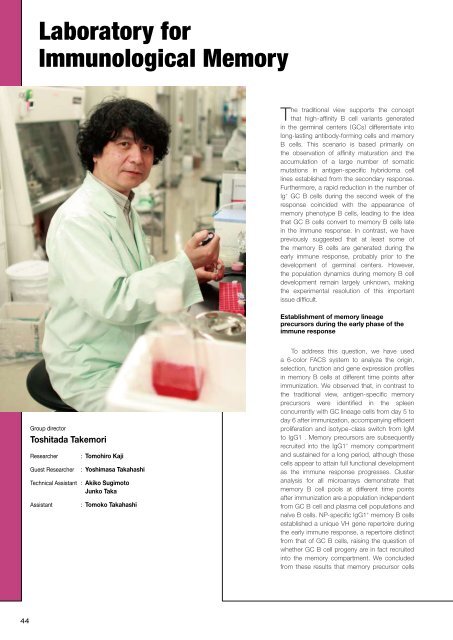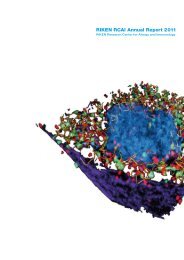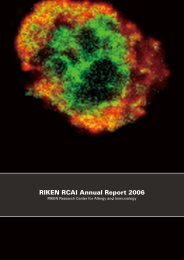in vivo
in vivo
in vivo
Create successful ePaper yourself
Turn your PDF publications into a flip-book with our unique Google optimized e-Paper software.
Laboratory for<br />
Immunological Memory<br />
The traditional view supports the concept<br />
that high-aff<strong>in</strong>ity B cell variants generated<br />
<strong>in</strong> the germ<strong>in</strong>al centers (GCs) differentiate <strong>in</strong>to<br />
long-last<strong>in</strong>g antibody-form<strong>in</strong>g cells and memory<br />
B cells. This scenario is based primarily on<br />
the observation of aff<strong>in</strong>ity maturation and the<br />
accumulation of a large number of somatic<br />
mutations <strong>in</strong> antigen-specific hybridoma cell<br />
l<strong>in</strong>es established from the secondary response.<br />
Furthermore, a rapid reduction <strong>in</strong> the number of<br />
Ig + GC B cells dur<strong>in</strong>g the second week of the<br />
response co<strong>in</strong>cided with the appearance of<br />
memory phenotype B cells, lead<strong>in</strong>g to the idea<br />
that GC B cells convert to memory B cells late<br />
<strong>in</strong> the immune response. In contrast, we have<br />
previously suggested that at least some of<br />
the memory B cells are generated dur<strong>in</strong>g the<br />
early immune response, probably prior to the<br />
development of germ<strong>in</strong>al centers. However,<br />
the population dynamics dur<strong>in</strong>g memory B cell<br />
development rema<strong>in</strong> largely unknown, mak<strong>in</strong>g<br />
the experimental resolution of this important<br />
issue difficult.<br />
Establishment of memory l<strong>in</strong>eage<br />
precursors dur<strong>in</strong>g the early phase of the<br />
immune response<br />
Group director<br />
Toshitada Takemori<br />
Researcher<br />
Guest Researcher<br />
: Tomohiro Kaji<br />
: Yoshimasa Takahashi<br />
Technical Assistant : Akiko Sugimoto<br />
Junko Taka<br />
Assistant<br />
: Tomoko Takahashi<br />
To address this question, we have used<br />
a 6-color FACS system to analyze the orig<strong>in</strong>,<br />
selection, function and gene expression profiles<br />
<strong>in</strong> memory B cells at different time po<strong>in</strong>ts after<br />
immunization. We observed that, <strong>in</strong> contrast to<br />
the traditional view, antigen-specific memory<br />
precursors were identified <strong>in</strong> the spleen<br />
concurrently with GC l<strong>in</strong>eage cells from day 5 to<br />
day 6 after immunization, accompany<strong>in</strong>g efficient<br />
proliferation and isotype-class switch from IgM<br />
to IgG1 . Memory precursors are subsequently<br />
recruited <strong>in</strong>to the IgG1 + memory compartment<br />
and susta<strong>in</strong>ed for a long period, although these<br />
cells appear to atta<strong>in</strong> full functional development<br />
as the immune response progresses. Cluster<br />
analysis for all microarrays demonstrate that<br />
memory B cell pools at different time po<strong>in</strong>ts<br />
after immunization are a population <strong>in</strong>dependent<br />
from GC B cell and plasma cell populations and<br />
naïve B cells. NP-specific IgG1 + memory B cells<br />
established a unique VH gene repertoire dur<strong>in</strong>g<br />
the early immune response, a repertoire dist<strong>in</strong>ct<br />
from that of GC B cells, rais<strong>in</strong>g the question of<br />
whether GC B cell progeny are <strong>in</strong> fact recruited<br />
<strong>in</strong>to the memory compartment. We concluded<br />
from these results that memory precursor cells<br />
44





